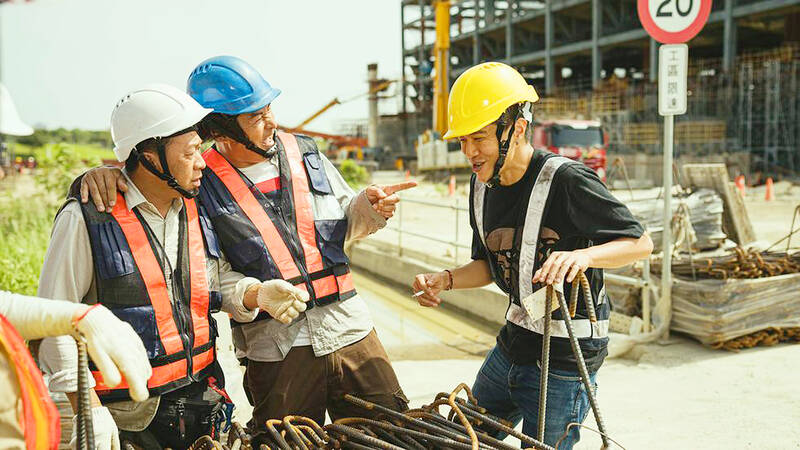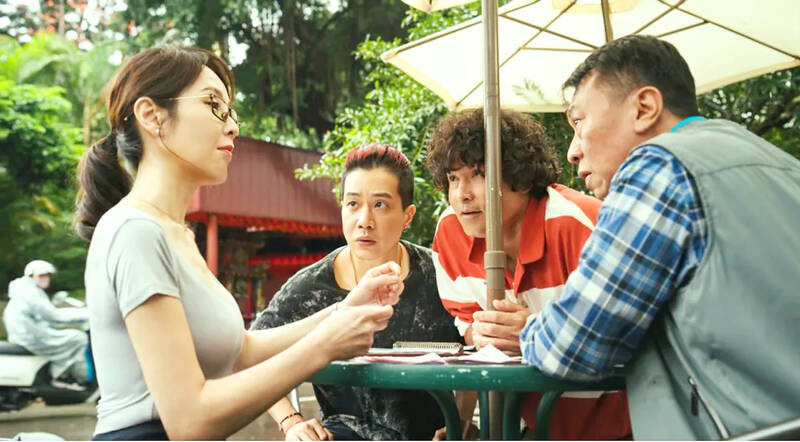You might have to watch the immensely popular 2020 television show Workers (做工的人) first to fully experience the emotional impact of the movie version. This reviewer admittedly didn’t, and although there’s quite a bit of background missing, it’s still a heartwarming crowd-pleaser showing the bonds between a group of struggling yet big-hearted laborers and their loved ones.
Set 11 years before the main events of the television series, the film is a prequel showing how three friends — A-chi (Christopher Lee, 李銘順), Brother Chang (Yu An-shun, 游安順) and A-quan (Hsueh Shih-ling, 薛仕凌) — met at the same construction site and developed an unbreakable friendship despite their age differences. A-chi is middle aged, Brother Chang probably in his 50s and A-quan in his 20s. Although they are best buds in the series, the actors have to press the reset button and act like they don’t know each other yet in the film.
The construction scenes are shot at the site of the massive and visually striking Taichung International Conference and Exhibition Center, and the actors trained hard to be able to effortlessly stroll and perform work on eight-story high beams under punishing temperatures. They said in an interview that the sites for the TV series were much less challenging and, while shooting the movie, they gained a renewed respect for this line of work.

Photo courtesy of Damou Entertainment and CPT Entertainment
A-chi’s son, Hsiao-chieh (Tang Hao-che, 唐浩哲), grown up in the TV series, is here a rebellious child who is bullied at school due to his father’s job and the family’s financial situation. Hsiao-chieh resents his father, constantly bickering with him and calling him a good-for-nothing. He later meets a classmate whose home situation is far worse and tries to help him renovate the dilapidated shack he lives in with his grandmother.
The three protagonists dream of being rich, and their harebrained schemes are a major plot in the television show. However, they’re careless and gullible, and keep falling for scams or getting into mishaps where they fall further into debt. This time, they desperately try to enter the popular TV game show “Who’s the Lucky One,” hosted by a hilariously tacky Aaron Yan (炎亞綸), with the prize being a new car, which they plan to sell. It seems that Yan has been making cameos in every other local film these days in roles that go against his pretty-boy image, which he pulls of here with amusing panache.
Although the tone is light-hearted, funny and a bit absurd, the hardships the characters face are still bitingly real, and there’s much sadness hidden beneath the characters’ carefree, trash-talking facades. People do look down on them, and in one scene A-chi feels too embarrassed to say hi to his son in the subway after a woman criticized his smelly, dirty work clothes. In another scene, A-quan talks candidly about being orphaned at a young age and having no family.

Photo courtesy of Damou Entertainment and CPT Entertainment
Despite this, they still enjoy life and time with their loved ones, who stick with them through thick and thin. Brother Chang’s wife (苗可麗, Miao Ke-li), who works at the construction site with him, especially stands out as strong and dominating yet caring and supportive, even during his screw-ups.
What stands out the most, however, is how generous and loyal the characters are toward each other. Even when they’re struggling, they are willing to drop everything and help. Although rather stereotypical, the characters are complex and fleshed out, and most importantly likable. It’s an effective way to bring attention to the less fortunate in society without being too exploitative, and it truly brings to life these nameless laborers we walk past every day.

Nov. 11 to Nov. 17 People may call Taipei a “living hell for pedestrians,” but back in the 1960s and 1970s, citizens were even discouraged from crossing major roads on foot. And there weren’t crosswalks or pedestrian signals at busy intersections. A 1978 editorial in the China Times (中國時報) reflected the government’s car-centric attitude: “Pedestrians too often risk their lives to compete with vehicles over road use instead of using an overpass. If they get hit by a car, who can they blame?” Taipei’s car traffic was growing exponentially during the 1960s, and along with it the frequency of accidents. The policy

Hourglass-shaped sex toys casually glide along a conveyor belt through an airy new store in Tokyo, the latest attempt by Japanese manufacturer Tenga to sell adult products without the shame that is often attached. At first glance it’s not even obvious that the sleek, colorful products on display are Japan’s favorite sex toys for men, but the store has drawn a stream of couples and tourists since opening this year. “Its openness surprised me,” said customer Masafumi Kawasaki, 45, “and made me a bit embarrassed that I’d had a ‘naughty’ image” of the company. I might have thought this was some kind

What first caught my eye when I entered the 921 Earthquake Museum was a yellow band running at an angle across the floor toward a pile of exposed soil. This marks the line where, in the early morning hours of Sept. 21, 1999, a massive magnitude 7.3 earthquake raised the earth over two meters along one side of the Chelungpu Fault (車籠埔斷層). The museum’s first gallery, named after this fault, takes visitors on a journey along its length, from the spot right in front of them, where the uplift is visible in the exposed soil, all the way to the farthest

The room glows vibrant pink, the floor flooded with hundreds of tiny pink marbles. As I approach the two chairs and a plush baroque sofa of matching fuchsia, what at first appears to be a scene of domestic bliss reveals itself to be anything but as gnarled metal nails and sharp spikes protrude from the cushions. An eerie cutout of a woman recoils into the armrest. This mixed-media installation captures generations of female anguish in Yun Suknam’s native South Korea, reflecting her observations and lived experience of the subjugated and serviceable housewife. The marbles are the mother’s sweat and tears,